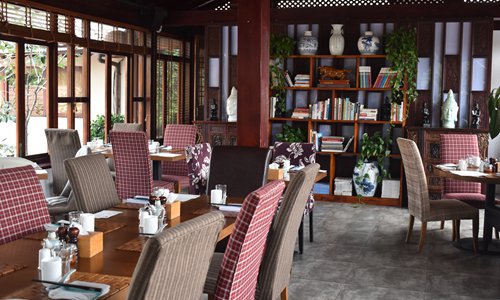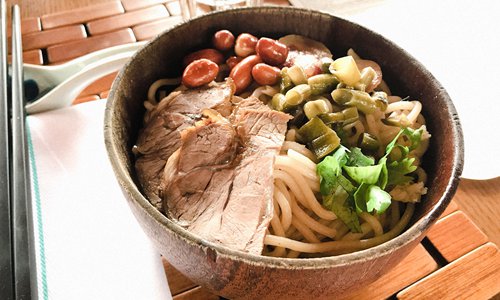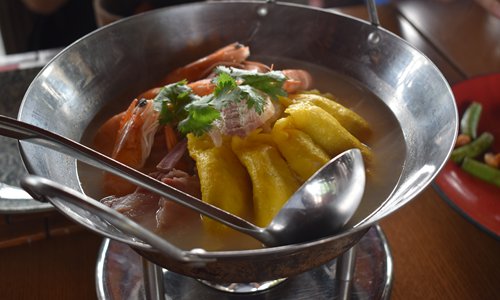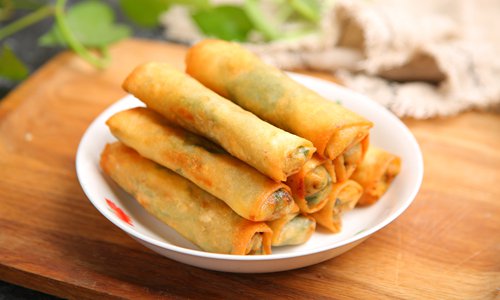HOME >> LIFE
Enjoy interesting stories behind traditional Chinese cuisines
By Chenxi Source:Global Times Published: 2019/8/14 14:58:06

The Jingshan Garden Hotel restaurant Photo: Chen Xi/GT

Guilin rice noodles Photo: Chen Xi/GT

'Yan Du Xian' Photo: Chen Xi/GT

Spring rolls Photo: IC
Located in Sanyanjing Hutong, one of Beijing's most historic hutongs (alleys), the Jingshan Garden Hotel is attracting tourists from all over the world not only for its ideal location and its chic decorations, but also for its delicious and lavish choice of Chinese cuisine."Although our hotel is not big, it is well equipped and has a strong taste of traditional Chinese characteristics. Nearly 90 percent of our customers are from abroad," Xu Lu, hotel manager of the Jingshan Garden Hotel, told the Global Times.
She said many foreign tourists like the design of Chinese courtyard in the hotel, and it is very convenient for them to visit many famous scenic spots in Beijing including the Forbidden City, the National Art Museum of China and Jingshan Park and Beihai Park on foot.
Meanwhile, they like to eat the Chinese food in our restaurant, Xu said, beaming with pride.
"We have two different menus each year. One is the Spring/Summer menu and the other is the Autumn/Winter menu because we want to provide the fresh seasonal vegetables to the guests," Xu said.
"I highly recommend three dishes in our restaurant including Guilin rice noodles, spring rolls and 'Yan Du Xian,'" Chen Linfeng, head chef of the hotel, told the Global Times.
Guilin rice noodles
Chen said the reason he recommends the noodles is because it has a long history and can represent one of the traditional Chinese cuisines in southern China.
According to Chen, Guilin rice noodles have a history of more than 2,300 years. It is said that Qin Shi Huang, the founder of the Qin Dynasty (221BC-206BC), took his army to southern China to wage war, aiming to unify southern China. However, the soldiers are from northern China and got used to eating wheat. They could not adapt to eating rice, which is the staple food in southern China, and couldn't digest it. In order to solve this problem, the chef had the idea to combine rice with wheat. They first inflated the rice and grinded it into rice syrup. After filtering the water from the rice syrup, the chef smashed the rice into rice dough and steamed it, and then pulled them into noodles. The noodles were cooked with some special brine made from traditional Chinese medicine that cured the soldiers' digestive problems. The soldiers regained their energy after eating the cooked rice noodles, and finally unified southern China, according to reports.
"There are more than 2,300 Guilin rice noodles chain restaurants in China, the figure that has surpassed the chain shop number of Lanzhou Beef Noodles, a popular noodle brand," Chen said. He also noted that every September or October, people from Guilin, South China's Guangxi Zhuang Autonomous Region hold a festival for making Guilin Rice Noodles in a super pot and invite thousands of people to come and enjoy the cuisine with the locals.
Spring rolls
The spring roll is rolled from a thin pancake made of rice and filled with meat and vegetables. The rolls are very crispy after being deep fried.
"The spring roll, a kind of traditional snack in northern China, is well known all over the world. Traditionally, the spring roll is very small, but the roll I make is big, which can be cut into two pieces for two people to eat," Chen said.
According to reports, a man from the Song Dynasty (960-1279) studied very hard and often forgot to eat meals. His wife reminded him to eat meals on time, but he failed, so she came up with the idea to make rice into a pancake, and filled it with meat and vegetables. By doing this, her husband could eat food from an entire meal in one roll, which was very convenient and nourishing.
'Yan Du Xian'
"Yan Du Xian is a southern China cuisine made of stewed salted pork and bamboo. But the dish I make is from soup stock instead of water so that the bamboo and meat taste very fresh," Chen said and noted that the dish has a very interesting historical story as well.
During Taiping Heavenly Kingdom (1851-1864), Hu Xueyan, a rich man in today's Zhejiang Province, liked eating ham. He ate hundreds of hams a year, so he had to hang the hams inside his house and the scent of the hams would float out of Hu's house when the weather was hot.
One day, Zuo Zongtang, an important figure in late Qing Dynasty (1644-1911), smelled the scent of ham when he passed by Hu's house and decided to visit him. Hu wanted to treat Zuo well, but he did not have any other food except ham. So, he improved his hometown's traditional dish named "Yan Dun Xian" by replacing bacon with ham and added some spring bamboo from his hometown in East China's Anhui Province. After stewing them, Hu invited Zuo to have a taste, and Zuo liked the dish very much. They talked a lot, and Hu promised Zuo to help him produce food.
Later, Zuo spread the dish by cooking and sharing it with the locals when he moved Shanghai. The dish became very popular in Shanghai, but when people asked about the name of dish, Zu pronounced "Yan Du Xian" wrong due to his hometown dialect of Central China's Hunan Province. Both "Dun" and "Du" mean stewing in Chinese.
Chen said he tried his best to make a menu that combined both the cuisine of northern and southern China so that the customers, especially the foreign visitors, will have enough choices to taste Chinese cuisines that have so many anecdotes behind them.
Newspaper headline: A taste of history
Posted in: FOOD,TOUCH OF WARMTH